"Breaking the Grass Ceiling" Challenges Women Experience in the Local Agriculture Sector
Summary Report
Breaking the Grass Ceiling - Summary Report.pdf (1.13 mb)
Women in Agriculture
For years farming has been perceived as a “male-dominated” industry and women in the sector have been overlooked or stereotyped as the wife, mother or daughter of a farmer.
There are many reasons for this including the tradition within farming families of passing farm ownership to a son(s) which limits the opportunities for women to pursue farming as a career.
Despite this, women play a vital role on farms undertaking hands-on tasks in addition to completing paperwork as well as running the household and looking after the family. Many women do this on-top of employment “off the farm.”
What is happening elsewhere?
In recent years there has been an increasing focus on the role of women in agriculture and the productivity benefits that women farmers bring to their businesses.
There is also evidence that more women are taking up farm ownership, for example there was a 27% increase in the number of women registered farm owners in the United States from 2012 to 2017.
Some countries have also introduced specific policies and initiatives in order to support women working in agriculture and those considering joining the sector, for example:
- Scotland has implemented a series of measures following the recommendations of a “Women in Agriculture Taskforce” including provision of personal development programmes for women in farming, training subsidy grants and roll-out of Board diversity training at large agri-food organisations
- The Irish government has pledged to increase grant support for women farmers to upgrade their machinery and equipment and establish women-only knowledge groups as part of its 2023-27 plans under the Common Agricultural Policy
Why did we look at this?
Women’s role in agriculture has received comparatively little policy attention and focus from public bodies and, historically, women’s interests in the sphere have been underrepresented.
In this context, and in light of measures adopted elsewhere, we wanted to understand the barriers that local women experience and what could be done to address these.
Also, given that agriculture is facing a period of flux due to the introduction of a new system of farm payments, climate change legislation and Brexit-related trade flows, we wanted to understand how greater promotion and support of women could help the sector meet these strategic challenges.
What did we do?
We undertook a range of activities to help us understand the issues including:
- Review of studies on women’s role in agriculture
- Data analysis of the composition of the local agricultural workforce (based on annual census statistics collated and published by the Department for Agriculture, Environment and Rural Affairs (DAERA)
- Benchmarking of policies in England, Scotland, Wales and Ireland
- We asked DAERA for information about its initiatives to support women in agriculture
- We sought the views of local women through an online survey that was accessible from 3 December 2021 to 14 January 2022: in total we received 178 responses from women living or working within the agricultural sector
- We held an event in February 2022 to hear from local women and stakeholder groups about what the issues are and how they could be addressed
What did we find?
The local agricultural sector is dominated by men and women are significantly underrepresented in terms of farm ownership, primary farmer activities, participation in training support groups and on the Boards of agri-food organisations.
The challenges women face are complex, multi-faceted and long-standing. Women experience a range of practical, social and cultural barriers which prevent them from taking on opportunities and progressing in the sector.
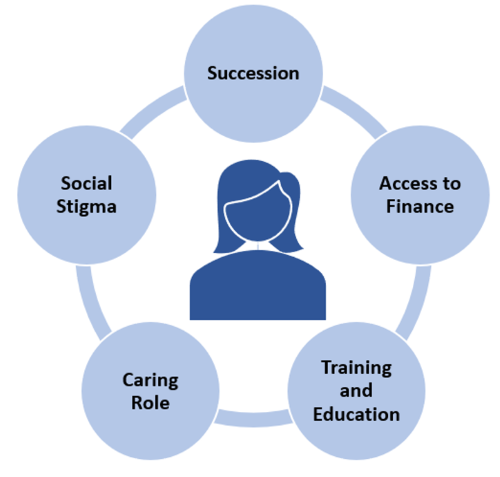
Data Analysis
- Women make up just 22% of the local agricultural workforce and this is a lower percentage than the UK-wide average
Office for National Statistics: Sex of Agriculture Workers 2020
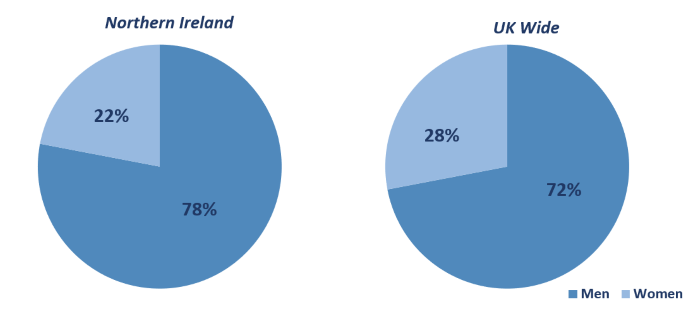
- Just 5% of registered principal local farmers in 2019 were women
- The number of women farmers fell by 15% between 2006 and 2019 and women are increasingly working in other/supportive roles in the sector
- We looked at the sex composition of Executives on the Boards of 14 local agri-food organisations: as of December 2021, 86% were men
- Women comprise just 4% of participants in Business Development Groups (BDGs) which facilitate knowledge-sharing and education of farmers with the aim of improving business technical efficiency and profitability
Percentage of Women BDG Members by County
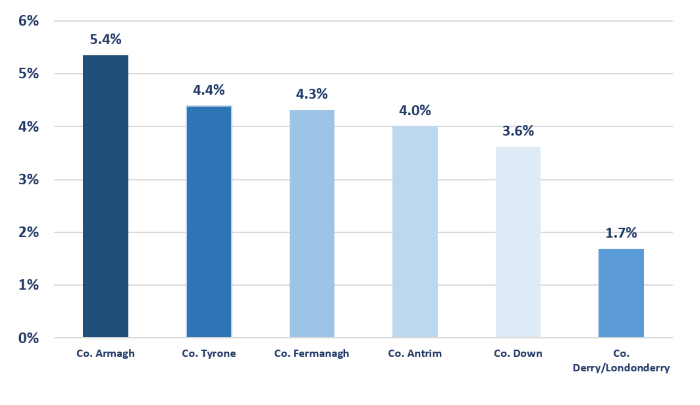
Survey Results
- 83% of respondents told us that a man owns the farm on which they live/work
- Just 15% of the women who completed our survey consider themselves to be the final decision-maker on their farm and 23% feel they have “Little to No Say” over farm decisions:
- 98% regularly participate in on-farm activities and just under a third undertake “hands-on” practical tasks in addition to supportive jobs like completion of paperwork and form-filling
- Women on local farms manage a diverse range of activities which are crucial to farm operations:
“I complete milking of the cows twice daily, as well as making diet feeds for the cows, I also scrape and bed cubicles. In the summer time I put in the grass which includes mowing, raking and lifting or baling and wrapping. I also help with the rearing of calves and administer medicine if cattle are sick. As well as outside jobs I complete most [of] the farm paper work as well.”
“I am the back bone of the farm...My jobs range from calving cows, lambing ewes, slurry spreading, farmyard manure spreading, rolling, mowing, tedding & baling all the silage/haylage & hay for the livestock to feed them over the winter months, then drawing and stacking off round bales, dosing & all the general day to day things to do with all the livestock.”
|
Weekly Hours on the Farm |
Respondents |
Percentage |
|
More than 40 hours per week |
34 |
19% |
|
30-40 hours per week |
30 |
17% |
|
20-30 hours per week |
38 |
21% |
|
10-20 hours per week |
35 |
20% |
|
Less than 10 hours per week |
40 |
22% |
- The vast majority of respondents work at least 20 hours on their farm per week and around a fifth work more than “full-time hours”
- 67% of respondents have employment off-the-farm and 41% of these women have used income from their jobs to subsidise farm expenses and/or secure finance for the business
View on Women's Role in Agriculture
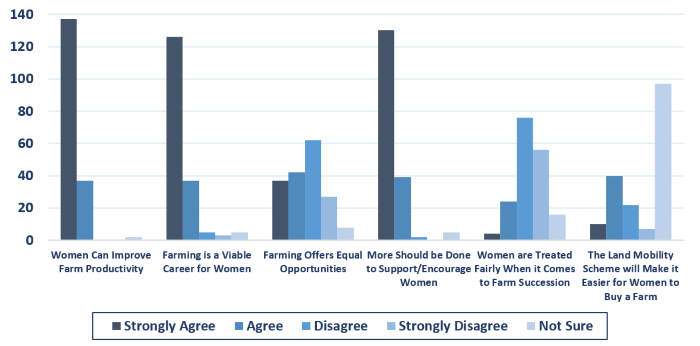
- 98% of respondents Strongly Agree/Agree that women help improve farm productivity and no respondents Disagree with this statement
- 95% Strongly Agree/Agree that more should be done to support women to take up the running of farms
- 92% Strongly Agree/Agree that farming offers a viable career opportunity for women
- 50% Strongly Disagree/Disagree that farming offers equal opportunities for men and women
- Only 15% Agree to some extent that women are treated fairly when it comes to farm succession
- While 20% of respondents Agree that the Land Mobility Scheme (LMS) will make it easier for women to take on ownership of farms, the majority of returnees are unsure about this
- The most important barriers cited by women who completed our survey were:
-
- Gaining ownership of farms and land
- Caring responsibilities
- Lack of support from family
- Underrepresentation of women role models
- Gender bias in the industry
- 70% of respondents told us that the culture within the sector is a challenge in that women are not respected as equals to men and there is an unacceptance of women farmers in some quarters:
“Women, especially young women, are not seen to be competent enough to run farms... As a woman in the agricultural sector, I frequently have men walk into the yard and immediately ask if my father or my husband is around.”
- Expectations of women to be responsible for childcare or look after elderly relatives was also cited as an important barrier as this limits opportunities to engage more extensively in farm activities
- A high number of respondents also reported feelings of low self-confidence amongst women in the sector due to social stigma and lack of opportunities
- We asked respondents what could be done to address the barriers and support women in the agricultural sphere and the main themes were:
-
- Challenging the male-dominated culture through educating all farmers, regardless of sex, of the changing composition of agricultural workforces in other places and the increasing role of women
- Showcasing the success and productivity of women-owned farms
- Leaders within the industry setting an example as to expected behaviours and a tone of gender acceptance
- Educating farmers about the need for early succession-planning and to consider all siblings as potential successors
- Promoting women role models in the sector
- Facilitating events and training networks specifically for women
Specifically with regard to training, respondents were keen to have more courses geared towards women to include education about practical on-farm tasks and that these should be delivered via a flexible format, i.e., online and accessible on-demand.
Financial support for training courses is also essential given the economic challenges in the sector and facilitation of “women-only” knowledge-groups and classes to avoid feelings of unease when participating in a male-dominated environment.
Ways to Encourage Training for Women Farmers
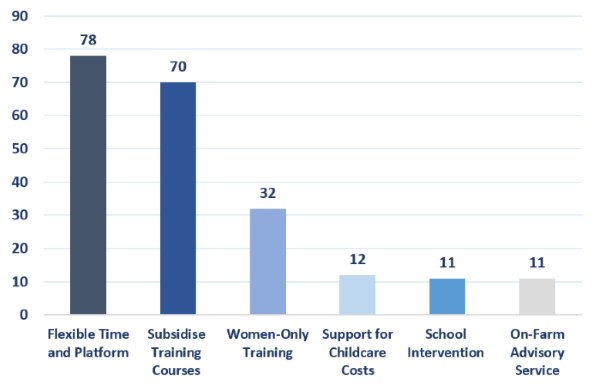
Respondents told us that tackling the traditional inheritance practices within the sector of always passing a farm to the son(s) in the family in order to “keep the farm in the family name” is crucial, and that the sex of siblings should not be a factor when making decisions about transition of farm ownership:
“Males in the family get first preference when the older generation are deciding to hand over the farm. Only if the boy is not interested will the girl be considered as a successor. The family name also comes into play, if a female succeeds the farm and marries the farm will no longer be in the original family name which may deter some from passing the farm to a female.”
Stakeholder Event
Our discussion with stakeholders confirmed many of the findings and issues arising from our survey and participants highlighted a number of additional challenges and measures which could be progressed to support women, including:
- The costs associated with childcare and provision in rural areas is an important barrier as women are expected to take primary responsibility for looking after the family
- Perinatal and pregnancy support: As self-employed workers there is no statutory maternity payment/leave for women farmers or support through pregnancy
- Women can experience prejudicial attitudes when accessing finance for a farm business. For example, a participant recollected that a bank was unwilling to approve a loan for the farm unless her husband countersigned the application
- Women are subjected to both implicit and explicit misogynistic behaviour in the sector – for example some participants experienced being offered a lower price for livestock at marts than male counterparts
- Affirmative Action should be endorsed, supported and delivered in the sector by actively seeking women representatives on Committees and Executive- level Boards
- Delivery of an academically-led independent review, as has been carried out in Scotland, may facilitate greater insight and understanding of how women can be better supported
- Unconscious Bias and/or Gender Equality training should be encouraged and facilitated in key organisations in the sector including at education facilities and representative groups
Attendees also reflected that local women represent an untapped resource for the local agricultural sector and that engaging more women as leaders would help the industry to modernise and diversify in response to the strategic challenges it is facing.
What do we recommend?
It is clear that women living and working in the local agricultural sector face a wide range of challenges and barriers, many of which are long-standing and interwoven with cultural practices: it will therefore take many years of persistent action to deliver parity of opportunity for women in the industry.
However, there are a number of practical and policy measures which can be adopted to promote, encourage and support women in the sector, including:
- The role of women within the agricultural sector should be formally acknowledged through tabling of a Motion debate at the Assembly
- DAERA should take specific actions to facilitate enhanced training and education for women in the sector to include:
-
- Design of programmes and course content which are specifically targeted at women farmers or those wanting to enter this role
-
- Ensure that provision of these programmes is flexible and made available online
-
- Establish a training subsidy grant specifically for women farmers to participate in courses (similar to provisions made in Scotland)
-
- Facilitation of “women-only” training forums similar to the Business Development Groups
- DAERA should ensure that provision is made to educate farm owners about the benefits women can bring to farm businesses and the importance of considering the suitability of all potential successors, regardless of sex
- DAERA should consider commissioning an independent, academically-led review to understand further the issues affecting women in the agricultural sector
- DAERA should ensure that appropriate equality, diversity and unconscious bias training is provided to its staff and in its Arm’s Length Bodies
- DAERA should consider facilitating awareness training for key agri-food organisations about the benefits of Board diversity and increasing representation of women
- Organisations across the sector should embrace affirmative action and seek to promote and encourage women where possible
- Leaders across the industry, both men and women, should seek to “set an example” of expected behaviours and gender equality and should showcase this at events like agricultural marts and livestock auctions
- When promoting a new initiative, policy or project, agri-food organisations should consider how women can be promoted in communication strategies
- DAERA should explore the feasibility of options for providing support for women farmers during and after pregnancy
You can read our full report here.



